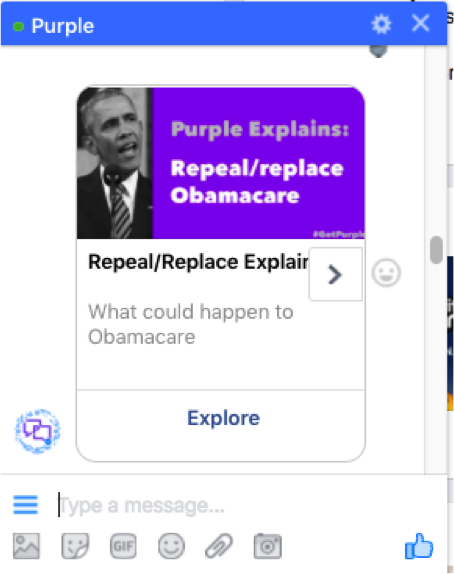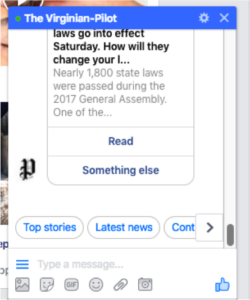
Purple: The Political Messenger
Creators: Rebecca Harris and David Heimann
Summary: Uses Facebook Messenger and SMS to add context to complex political news.
_____________________________________________
The concept behind Purple is simple: Get explanations about complicated political events or issues as if you were asking a smart friend. No jargon, just a bit of wonkiness, and more information only if you want it.
In fact, the idea for Purple came to its co-creators Rebecca Harris and David Heimann in “a lightbulb moment” when they realized their friends were constantly texting them for explanations about the latest political controversies rather than reading lengthy news stories. “Unless you’re a news junkie, the amount of information is overwhelming,” says Harris.
In its initial launch Purple worked like an online concierge service — Mezi or Magic, for example — not for clothing or travel services, but for political information.
First, people signed up for Purple on Facebook Messenger or SMS. Particularly during breaking news or planned political events — such as a debate — subscribers received a message like this:

The message typically contained a bold-type keyword, a link, or an “Explore” or “Next” button. Users clicked one of those buttons to get more information. Or not.

Purple began as a Tumblr blog called “Purple Politics” while Harris was a graduate student at CUNY’s journalism school. (“Purple” represents the color combination of “red” politics and “blue” politics.)
Later it became a website “that did explainers in a non-partisan way.” Harris says the site “was popular, but not growing.” So Purple began signing up users for SMS, and later, Facebook Messenger. (Harris is considering Slack and WhatsApp as well.)
“It’s really powerful to have a platform that people use naturally,” she said.
Today, Harris and Heimann are beta-testing a built-out platform that allows other writers to offer their political expertise through Purple. “What we really want to do is build a new model for media that emphasizes quality over quantity,” she said. “No one will be sending you to fake news or false content.”
Harris said she’s vetting the writing applicants for quality and trustworthiness; so far, the authors include political reporter Philip Rosenstein “and bloggers who don’t work for large organizations.”
Purple will retain the concept of having real faces behind their information, says Harris. “People connect more naturally with other people, rather than faceless sources. When you engage with people the same way you’d engage with your friends, it creates incredibly high levels of trust and loyalty.”
Technical points and modifications: Purple uses Twilio to handle its SMS (text message) communications. The biggest challenges to using SMS, says Harris, is cost and segmentation. “There are unique challenges when you’re communicating with a lot of people via SMS,” she says. However, Facebook Messenger is “pretty simple and straightforward; not too many technical challenges there.”
Newsrooms including The Virginian-Pilot also are testing the Facebook Messenger platform to distribute links to news stories. At the Pilot, Facebook users can choose how, when and what types of content they’ll receive — all facilitated by an automated assistant named Ginny. Another resource: Melody Kramer’s recent list of news organizations’ creative uses of messaging platforms.
Share with your network
Improving accountability reporting
You also might be interested in:
As research continues to inform this slice of the news industry, we’ll continue learning, too. Who gets to be called a journalist in 2025 and beyond? What is the future of trustworthy information, especially considering the access to and trust for online content creators? How might journalism adapt to the rise, or co-opt the styles, of news influencers?
What if we started looking at our output as a product, not a service? Too often, we think "product" means a fancy app or a new website. But product isn’t about tech. It’s about intention.
When we began asking what kind of stories still mattered to Baca County, we realized many of them weren’t “breaking news” but generational memory. And the paper was the last remaining platform that treated those memories with care and context.



